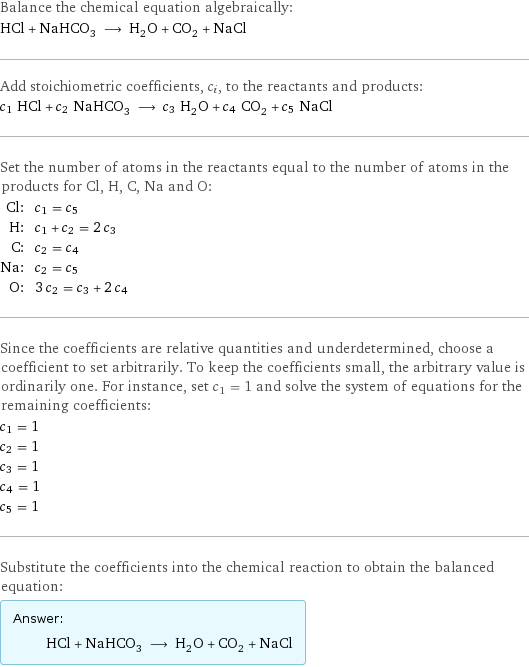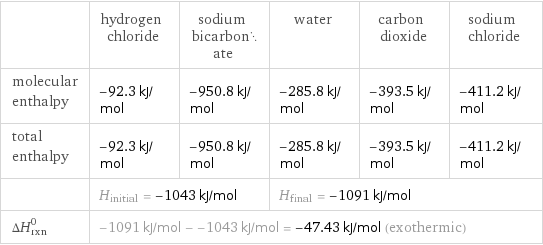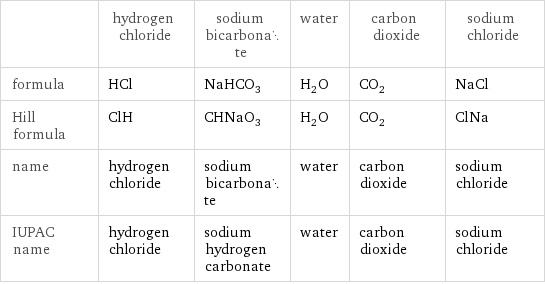Input interpretation

HCl (hydrogen chloride) + NaHCO_3 (sodium bicarbonate) ⟶ H_2O (water) + CO_2 (carbon dioxide) + NaCl (sodium chloride)
Balanced equation

Balance the chemical equation algebraically: HCl + NaHCO_3 ⟶ H_2O + CO_2 + NaCl Add stoichiometric coefficients, c_i, to the reactants and products: c_1 HCl + c_2 NaHCO_3 ⟶ c_3 H_2O + c_4 CO_2 + c_5 NaCl Set the number of atoms in the reactants equal to the number of atoms in the products for Cl, H, C, Na and O: Cl: | c_1 = c_5 H: | c_1 + c_2 = 2 c_3 C: | c_2 = c_4 Na: | c_2 = c_5 O: | 3 c_2 = c_3 + 2 c_4 Since the coefficients are relative quantities and underdetermined, choose a coefficient to set arbitrarily. To keep the coefficients small, the arbitrary value is ordinarily one. For instance, set c_1 = 1 and solve the system of equations for the remaining coefficients: c_1 = 1 c_2 = 1 c_3 = 1 c_4 = 1 c_5 = 1 Substitute the coefficients into the chemical reaction to obtain the balanced equation: Answer: | | HCl + NaHCO_3 ⟶ H_2O + CO_2 + NaCl
Structures

+ ⟶ + +
Names

hydrogen chloride + sodium bicarbonate ⟶ water + carbon dioxide + sodium chloride
Reaction thermodynamics
Enthalpy

| hydrogen chloride | sodium bicarbonate | water | carbon dioxide | sodium chloride molecular enthalpy | -92.3 kJ/mol | -950.8 kJ/mol | -285.8 kJ/mol | -393.5 kJ/mol | -411.2 kJ/mol total enthalpy | -92.3 kJ/mol | -950.8 kJ/mol | -285.8 kJ/mol | -393.5 kJ/mol | -411.2 kJ/mol | H_initial = -1043 kJ/mol | | H_final = -1091 kJ/mol | | ΔH_rxn^0 | -1091 kJ/mol - -1043 kJ/mol = -47.43 kJ/mol (exothermic) | | | |
Gibbs free energy

| hydrogen chloride | sodium bicarbonate | water | carbon dioxide | sodium chloride molecular free energy | -95.3 kJ/mol | -851 kJ/mol | -237.1 kJ/mol | -394.4 kJ/mol | -384.1 kJ/mol total free energy | -95.3 kJ/mol | -851 kJ/mol | -237.1 kJ/mol | -394.4 kJ/mol | -384.1 kJ/mol | G_initial = -946.3 kJ/mol | | G_final = -1016 kJ/mol | | ΔG_rxn^0 | -1016 kJ/mol - -946.3 kJ/mol = -69.3 kJ/mol (exergonic) | | | |
Entropy

| hydrogen chloride | sodium bicarbonate | water | carbon dioxide | sodium chloride molecular entropy | 187 J/(mol K) | 102 J/(mol K) | 69.91 J/(mol K) | 214 J/(mol K) | 72 J/(mol K) total entropy | 187 J/(mol K) | 102 J/(mol K) | 69.91 J/(mol K) | 214 J/(mol K) | 72 J/(mol K) | S_initial = 289 J/(mol K) | | S_final = 355.9 J/(mol K) | | ΔS_rxn^0 | 355.9 J/(mol K) - 289 J/(mol K) = 66.91 J/(mol K) (endoentropic) | | | |
Equilibrium constant
![Construct the equilibrium constant, K, expression for: HCl + NaHCO_3 ⟶ H_2O + CO_2 + NaCl Plan: • Balance the chemical equation. • Determine the stoichiometric numbers. • Assemble the activity expression for each chemical species. • Use the activity expressions to build the equilibrium constant expression. Write the balanced chemical equation: HCl + NaHCO_3 ⟶ H_2O + CO_2 + NaCl Assign stoichiometric numbers, ν_i, using the stoichiometric coefficients, c_i, from the balanced chemical equation in the following manner: ν_i = -c_i for reactants and ν_i = c_i for products: chemical species | c_i | ν_i HCl | 1 | -1 NaHCO_3 | 1 | -1 H_2O | 1 | 1 CO_2 | 1 | 1 NaCl | 1 | 1 Assemble the activity expressions accounting for the state of matter and ν_i: chemical species | c_i | ν_i | activity expression HCl | 1 | -1 | ([HCl])^(-1) NaHCO_3 | 1 | -1 | ([NaHCO3])^(-1) H_2O | 1 | 1 | [H2O] CO_2 | 1 | 1 | [CO2] NaCl | 1 | 1 | [NaCl] The equilibrium constant symbol in the concentration basis is: K_c Mulitply the activity expressions to arrive at the K_c expression: Answer: | | K_c = ([HCl])^(-1) ([NaHCO3])^(-1) [H2O] [CO2] [NaCl] = ([H2O] [CO2] [NaCl])/([HCl] [NaHCO3])](../image_source/76afcedff05b50e668c2f83b89934009.png)
Construct the equilibrium constant, K, expression for: HCl + NaHCO_3 ⟶ H_2O + CO_2 + NaCl Plan: • Balance the chemical equation. • Determine the stoichiometric numbers. • Assemble the activity expression for each chemical species. • Use the activity expressions to build the equilibrium constant expression. Write the balanced chemical equation: HCl + NaHCO_3 ⟶ H_2O + CO_2 + NaCl Assign stoichiometric numbers, ν_i, using the stoichiometric coefficients, c_i, from the balanced chemical equation in the following manner: ν_i = -c_i for reactants and ν_i = c_i for products: chemical species | c_i | ν_i HCl | 1 | -1 NaHCO_3 | 1 | -1 H_2O | 1 | 1 CO_2 | 1 | 1 NaCl | 1 | 1 Assemble the activity expressions accounting for the state of matter and ν_i: chemical species | c_i | ν_i | activity expression HCl | 1 | -1 | ([HCl])^(-1) NaHCO_3 | 1 | -1 | ([NaHCO3])^(-1) H_2O | 1 | 1 | [H2O] CO_2 | 1 | 1 | [CO2] NaCl | 1 | 1 | [NaCl] The equilibrium constant symbol in the concentration basis is: K_c Mulitply the activity expressions to arrive at the K_c expression: Answer: | | K_c = ([HCl])^(-1) ([NaHCO3])^(-1) [H2O] [CO2] [NaCl] = ([H2O] [CO2] [NaCl])/([HCl] [NaHCO3])
Rate of reaction
![Construct the rate of reaction expression for: HCl + NaHCO_3 ⟶ H_2O + CO_2 + NaCl Plan: • Balance the chemical equation. • Determine the stoichiometric numbers. • Assemble the rate term for each chemical species. • Write the rate of reaction expression. Write the balanced chemical equation: HCl + NaHCO_3 ⟶ H_2O + CO_2 + NaCl Assign stoichiometric numbers, ν_i, using the stoichiometric coefficients, c_i, from the balanced chemical equation in the following manner: ν_i = -c_i for reactants and ν_i = c_i for products: chemical species | c_i | ν_i HCl | 1 | -1 NaHCO_3 | 1 | -1 H_2O | 1 | 1 CO_2 | 1 | 1 NaCl | 1 | 1 The rate term for each chemical species, B_i, is 1/ν_i(Δ[B_i])/(Δt) where [B_i] is the amount concentration and t is time: chemical species | c_i | ν_i | rate term HCl | 1 | -1 | -(Δ[HCl])/(Δt) NaHCO_3 | 1 | -1 | -(Δ[NaHCO3])/(Δt) H_2O | 1 | 1 | (Δ[H2O])/(Δt) CO_2 | 1 | 1 | (Δ[CO2])/(Δt) NaCl | 1 | 1 | (Δ[NaCl])/(Δt) (for infinitesimal rate of change, replace Δ with d) Set the rate terms equal to each other to arrive at the rate expression: Answer: | | rate = -(Δ[HCl])/(Δt) = -(Δ[NaHCO3])/(Δt) = (Δ[H2O])/(Δt) = (Δ[CO2])/(Δt) = (Δ[NaCl])/(Δt) (assuming constant volume and no accumulation of intermediates or side products)](../image_source/eec5a43d1e4daabe9d64cb9629216bab.png)
Construct the rate of reaction expression for: HCl + NaHCO_3 ⟶ H_2O + CO_2 + NaCl Plan: • Balance the chemical equation. • Determine the stoichiometric numbers. • Assemble the rate term for each chemical species. • Write the rate of reaction expression. Write the balanced chemical equation: HCl + NaHCO_3 ⟶ H_2O + CO_2 + NaCl Assign stoichiometric numbers, ν_i, using the stoichiometric coefficients, c_i, from the balanced chemical equation in the following manner: ν_i = -c_i for reactants and ν_i = c_i for products: chemical species | c_i | ν_i HCl | 1 | -1 NaHCO_3 | 1 | -1 H_2O | 1 | 1 CO_2 | 1 | 1 NaCl | 1 | 1 The rate term for each chemical species, B_i, is 1/ν_i(Δ[B_i])/(Δt) where [B_i] is the amount concentration and t is time: chemical species | c_i | ν_i | rate term HCl | 1 | -1 | -(Δ[HCl])/(Δt) NaHCO_3 | 1 | -1 | -(Δ[NaHCO3])/(Δt) H_2O | 1 | 1 | (Δ[H2O])/(Δt) CO_2 | 1 | 1 | (Δ[CO2])/(Δt) NaCl | 1 | 1 | (Δ[NaCl])/(Δt) (for infinitesimal rate of change, replace Δ with d) Set the rate terms equal to each other to arrive at the rate expression: Answer: | | rate = -(Δ[HCl])/(Δt) = -(Δ[NaHCO3])/(Δt) = (Δ[H2O])/(Δt) = (Δ[CO2])/(Δt) = (Δ[NaCl])/(Δt) (assuming constant volume and no accumulation of intermediates or side products)
Chemical names and formulas

| hydrogen chloride | sodium bicarbonate | water | carbon dioxide | sodium chloride formula | HCl | NaHCO_3 | H_2O | CO_2 | NaCl Hill formula | ClH | CHNaO_3 | H_2O | CO_2 | ClNa name | hydrogen chloride | sodium bicarbonate | water | carbon dioxide | sodium chloride IUPAC name | hydrogen chloride | sodium hydrogen carbonate | water | carbon dioxide | sodium chloride